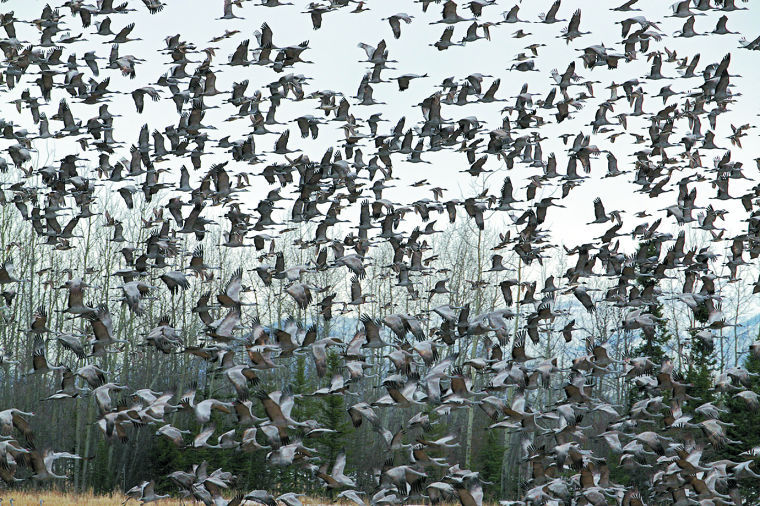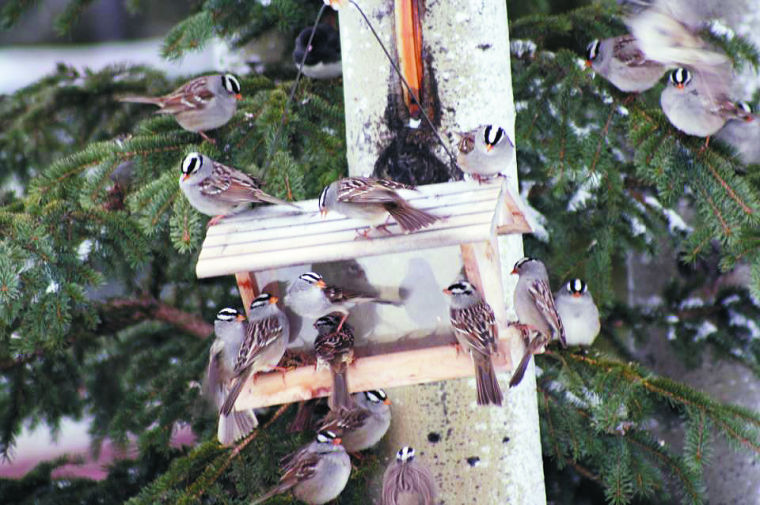
Part of a huge flock of sandhill cranes take to the air after being scared by a bald eagle in Delta Junction on Saturday night off Barley Way. Photographer Jim DeWitt estimated there were 3,000 cranes in the flock.
Bud Johnson in Tok estimates there were 100,000 sparrows descending on that area Tuesday. He reported seeing continuous flocks along the sides of the highway, and came home to hundreds of songbirds in his yard. White-crowned, golden-crowned, fox and tree sparrows mixed with juncos, rusty blackbirds and Lapland longspurs. Other viewers saw Lincoln's and Savannah sparrows and gray-crowned rosy-finches.
"I have never seen anything like this ever," Johnson said. "The ground is just in constant movement and the singing (mostly from the white-crowned sparrows) is insane."
Among bird-watchers, there is a phenomenon called "fallout," which is when a large number of migrating birds make landfall because they run into storm systems. Usually this happens along the coast, where exhausted birds touch down on the first solid ground they find. It's possible a combination of the late spring breakup and a current weather front has caused this unusual spring gathering.
"This is turning out to be the most spectacular spring migration I think the Tanana Valley has seen in recent memory," Fairbanks birder Nancy DeWitt wrote in an email. "First, there were the unprecedented numbers of swans and white-fronted geese in the Delta barley fields (many of which are still there) accompanied by the biggest flocks of Canada geese and pintails I've ever seen, now followed by what Steve Dubois says is the largest concentration of sandhill cranes he's seen in his 28 years there.
"Add in the numerous bluebird sightings (I've lost count), cloud after cloud of Lapland longspurs moving through the valley, thick groups of varied thrush at Fort Greely on Saturday night, and now the sparrow fall-out in Tok Bud describes, and I am just beside myself with glee," she said. "I assume most of this is weather related, but what happened and where along the migration route that balled up all these birds? I suppose the fact that a lot of the valley is snow-covered and many ponds and lakes are still frozen is also concentrating birds, but would sure love to know if anyone tracked migration radar data over Canada in the past month.

Swainson's hawk spied in Fairbanks
Although Swainson's hawks are a North American bird, they are uncommon in Alaska, which is why it was big news when birders spotted one in Fairbanks during the weekend near the float pond at the airport.
Some hard-core birders from Anchorage and Seward made the trip to Fairbanks to see the hawk. Another Swainson's hawk was reported near Delta, adding to the madness that is migration in the Interior this spring.
The woods are alive with music
Songbirds arrived in force last weekend in the Interior. Yards that were quiet one day were suddenly filled with bird song the next.
Observers saw large numbers of varied thrushes by Fort Greely last weekend. Songbirds are also returning full force in Fairbanks, with reports of large flocks of Lapland longspurs. Someone also saw a Swainson's thrush. A few people have spotted Townsend's warblers, which oddly enough seem to be early, along with yellow-rumped and yellow warblers. Tree and violet-green swallows once again dart above Creamer's Field and the Chena River.
Other returning songbirds noted this past week include olive-sided and Hammond's flycatchers and American pipits.
American robins, meanwhile, still seem few and far between.
Crowds of cranes in Delta Junction
Exceptionally high numbers of sandhill cranes continue to flock to the Delta area. There are usually several thousand cranes there, but Delta Junction bird watcher Steve Dubois estimated at least 12,000 on the barley fields Monday.
"The remarkable thing is the number of birds right now," he commented.
Jim DeWitt captured some amazing photos of cranes last Saturday after a bald eagle put up a huge flock of approximately 3,000 cranes. The sight was "one of the most amazing birding experiences of my life," he said.
Raptor reports are on the rise
A few new raptors showed up this past week. Short-eared owls are following the crowd, with one spotted at Fairbanks International Airport and more in Delta. Ospreys have showed up along the Chena River and in Delta. Merlins have also put in appearances, and there seem to be unusually high numbers of northern harriers being spotted this spring.
Robert Levesque, who lives on the Chena River just upstream from the Princess Hotel off Pike's Landing Road, has been watching a pair of osprey fishing in the Chena.
"There's been a pair that's been hanging around harvesting fish," said Levesque, who has had fun photographing the birds from his back yard. "They dive all the way into the river so that just a few feathers are showing and pop out with a fish."
Shorebirds wading in
Shorebirds continue to alight, including yellowlegs, dowitchers, red-necked phalaropes, Wilson's snipe, and semipalmated, solitary, pectoral, and least sandpipers. Whimbrels, chicken-sized birds with long, curved bills, were seen at the airport and out in Tok. There were sightings of a killdeer at Creamer's Field.
Sharp-tails are dancing
Birders report more sharp-tailed grouse around Delta this spring than they can remember in the last 20 years and males are now strutting their stuff for the ladies.
The male birds gather on performance grounds, called "leks," each defending a mini territory where he dances to attract females: wings outstretched, head down, tail straight up, he does a fast tap-dance. Females visit the lek to shop for a mate, then nest elsewhere and raise the chicks alone.
Waterfowl still tricking in
In Fairbanks, a ring-necked duck joined more than 100 canvasback ducks on the Chena River near the Boatel bar. Other new waterfowl in the area include greater and lesser scaup, along with both horned grebes and larger red-necked grebes and a common loon.
Tanana Lakes finally thawing
Tanana Lakes in Fairbanks is finally thawing out on the east end, so you'll find good looks at birds from South Cushman Street. Observers have enjoyed a variety of waterfowl including ducks, horned grebes, shorebirds and Bonaparte's gulls.
Rare swans in Delta
Several people reported at least one, and possibly two, Bewick's swans mingling with tundra and trumpeter swans in the agricultural lands around Delta last weekend.
This subspecies of tundra swan lives in Europe and Asia. While North American tundra swans (also named whistling swans because of their high-pitched calls) have a small, bright yellow teardrop at the base of their bills, Bewick's swans have a noticeably larger yellow patch that covers the top of the bill from the base to the nostrils.



Reader Comments
to our Newsletter